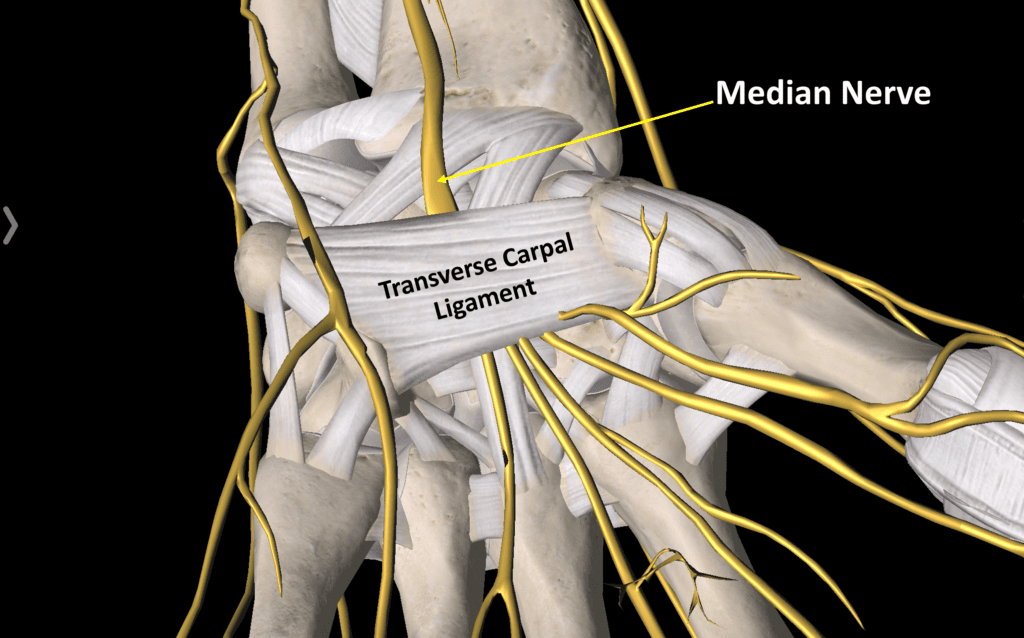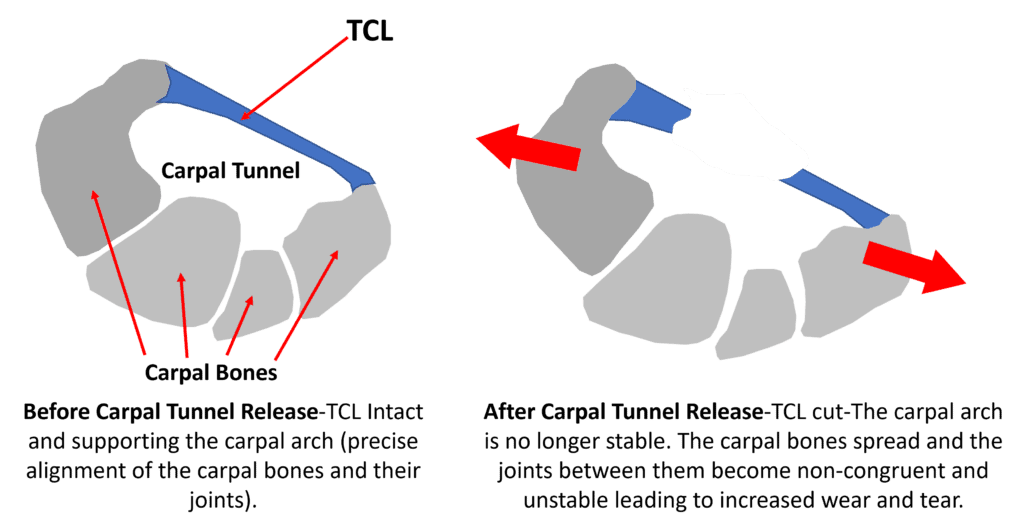Carpal Tunnel Release and Wrist Instability

Credit: Shutterstock
I was on a telemedicine visit with a physician-patient and he brought up that he regretted his carpal tunnel release because that caused an unstable and arthritic wrist. So is this a thing? Does carpal tunnel release cause wrist arthritis? Let’s dig in.
What is Carpal Tunnel Syndrome?

Since carpal tunnel release is the treatment we’re reviewing here, let’s start with what that’s meant to address: Carpal Tunnel Syndrome (CTS). CTS symptoms include pain or numbness in the thumb that’s made worse by using the wrist. When the condition is chronic or severe, the meaty part of the thumb (APB muscle) can begin to atrophy (get smaller), leading to hand weakness.
As shown above, in the wrist, the median nerve dives under the transverse carpal ligament (TCL). In the 1950s conceptualization of CTS, the nerve is accompanied by lots of tendons, and when those swell, the nerve can get crowded out and the pressure can begin to cause the nerve to misfire. Because of that limited understanding of CTS, the surgeon’s approach to the problem has been to cut the transverse carpal ligament, which is called a Carpal Tunnel Release (CTR).
This 1950s concept of carpal tunnel syndrome has caused millions worldwide to get this ligament cut. However, this begs all sorts of questions. First, if the tendons are swelling, why not treat the tendons to get pressure off the nerve? Also, this nerve doesn’t exist in isolation, meaning it starts in the neck as a spinal nerve and also goes through lots of other tight spots like the thoracic outlet in the shoulder. Hence, how do we know that what we’re really treating isn’t a neck or a Thoracic Outlet Syndrome issue? Finally, this ligament serves the function of stabilizing wrist bones, so if we cut it, will that cause wrist instability?
Where is The Nerve Problem?
Hyperspecialization in musculoskeletal medicine is a two-edged sword. For example, someone with CTS is often sent to a hand surgeon. That surgeon has developed no diagnostic skills looking at other areas for possible nerve issues like irritated spinal nerves in the neck or TOS in the shoulder, so to them, any problem that causes numbness in the thumb MUST be CTS. However, clinical reality is different. For example, we see patients all day every day who have pain/numbness in the thumb where the bigger problem is in the neck and the CTS is merely a sideshow. Hence, if you cut the TCL, the patient may get better for a while, but then the issue comes back. Hence, the wrist and neck (and sometimes shoulder) usually need to be treated together.
Carpal Tunnel Release and Wrist Instability
I always tell patients that there are no spare parts in the body. Everything has a function. Hence, if you remove something or cut it, there will ALWAYS be secondary negative consequences. The only questions to be answered are what are those side effects, how much will they impact the patient, and are they worth it?
As early as the 1980s, it became clear that cutting the TCL made the carpal bones of the wrists more unstable (1). By the mid-90s, researchers noted that cutting the TCL shortened and weakened the hand muscles (2). Several studies have noted that the tendons that flex your fingers are reduced in efficiency when the TCL is cut. Other authors have linked this to the later development of trigger finger (3,4). We also believe that cutting the TCL destabilizes the wrist leading to a probable higher likelihood of wrist arthritis down the road (5,6). Why? The TCL maintains the carpal arch which is critical for the carpal bones in the wrist to be able to function normally. So to summarize, there is no free lunch with cutting the TCL, it has biomechanical consequences.

I love creating my own medical illustrations. I guess this harkens back to when I was a kid and would draw for hours on end. It also helps to make complex concepts simple for my patients. To that end, note that the image on the left shows how the TCL supports the carpal arch. The “carpal bones” are the little bones in your wrist that move in very specific ways to allow normal hand motion. The image on the right clearly shows how cutting the TCL destabilizes that arch and the carpal bones, causing the wrist to become unstable and destroying the normal alignment of these bones and their joints. This extra motion causes more wear and tear and over time eventually leads to arthritis.
Big Surgeries or Small Surgeries All Do the Same Thing
Surgery has been moving towards less invasive procedures for decades. For example, the open-heart surgery of the 1980s has now largely been replaced by catheter-based interventional cardiology procedures. The same thing is happening in carpal tunnel procedures. Open wrist surgeries to cut the TCL have morphed into smaller procedures now using ultrasound and specific devices. The positive is that smaller procedures generally mean fewer complications. The negative is that you’re still cutting the TCL, which, as shown above, has long-term implications.
This move toward less invasive procedures in my own field of interventional orthopedics has been interesting to watch. On the one hand, I generally support moving patients from surgeries to needle-based procedures. Some of the newest interventional carpal tunnel release devices do allow non-surgeon interventionists to release the TCL. However, at the same time, what we’re supposed to be doing in interventional orthobiologics is to help the problem without removing or cutting tissue. Hence, at what point do my colleagues just become surgeons through smaller incisions rather than offering truly groundbreaking and disruptive technology to help heal the body? That’s why to date, I have avoided the new devices being sold to cut the TCL through a smaller incision.
Why Not Just Inject PRP?
We have a number of Randomized Controlled Trials that show that Carpal Tunnel Syndrome (CTS) can be successfully treated with an injection of platelet-rich plasma (PRP) (7-10). This begs the question of whether the compression theory of CTS is correct at all or for most patients. What I mean is that the 1950s idea behind CTS is that the nerve is being crushed by the TCL and hence we need to cut that ligament. If that’s the mechanism behind the problem, then how can the injection of PRP (which has beneficial growth factors that may help the health of the nerve) possibly work? The answer may be that the problem is more about the health of the nerve than the compression of the structure.
Median Nerve Hydrodissection
Taking the above idea one step further, why not use platelet growth factors, but delicately inject those around the nerve to break up any scar tissue (covering the mechanical compression theory) and to help the nerve function better. For example, we know that PRP has both VEGF which builds new blood vessels and NGF which helps to heal nerves (11,12). We’ve been successfully using this approach for years and have prevented many patients from needing CTR. My video below shows how this advanced ultrasound-guided procedure looks on imaging:
The upshot? My physician-patient was right. Carpal tunnel release is likely associated with wrist instability. In other words, you can’t cut the transverse carpal ligament without consequences. Hence, we should be offering regenerative care for carpal tunnel syndrome long before we consider cutting the TCL. Only if interventional orthobiologics fails should we consider cutting a critical supporting structure of the wrist using new and less invasive devices.
__________________________________________________
References:
(1) Garcia-Elias M, An KN, Cooney WP 3rd, Linscheid RL, Chao EY. Stability of the transverse carpal arch: an experimental study. J Hand Surg Am. 1989 Mar;14(2 Pt 1):277-82. doi: 10.1016/0363-5023(89)90021-x. PMID: 2703675.
(2) Fuss FK, Wagner TF. Biomechanical alterations in the carpal arch and hand muscles after carpal tunnel release: a further approach toward understanding the function of the flexor retinaculum and the cause of postoperative grip weakness. Clin Anat. 1996;9(2):100-8. doi: 10.1002/(SICI)1098-2353(1996)9:2<100::AID-CA2>3.0.CO;2-L. PMID: 8720784.
(3) Kiritsis PG, Kline SC. Biomechanical changes after carpal tunnel release: a cadaveric model for comparing open, endoscopic, and step-cut lengthening techniques. J Hand Surg Am. 1995 Mar;20(2):173-80. doi: 10.1016/S0363-5023(05)80003-6. PMID: 7775747.
(4) Lee SK, Bae KW, Choy WS. The relationship of trigger finger and flexor tendon volar migration after carpal tunnel release. J Hand Surg Eur Vol. 2014 Sep;39(7):694-8. doi: 10.1177/1753193413479506. Epub 2013 Feb 26. PMID: 23442341.
(5) Morrell NT, Harris A, Skjong C, Akelman E. Carpal tunnel release: do we understand the biomechanical consequences? [published correction appears in J Wrist Surg. 2016 May;5(2):167]. J Wrist Surg. 2014;3(4):235-238. doi:10.1055/s-0034-1394363
(6) Kimura H, Sato K, Matsumura N, Suzuki T, Iwamoto T, Ohori K, Yamada Y, Matsumoto M, Nakamura M, Jinzaki M, Nagura T. Evaluation of Dynamic Carpal Arch Stability following Carpal Tunnel Release Using Four-Dimensional Computed Tomography. J Hand Microsurg. 2021 Jul;13(3):138-142. doi: 10.1055/s-0040-1718969. Epub 2020 Nov 19. PMID: 34511829; PMCID: PMC8426082.
(7) Kimura H, Sato K, Matsumura N, Suzuki T, Iwamoto T, Ohori K, Yamada Y, Matsumoto M, Nakamura M, Jinzaki M, Nagura T. Evaluation of Dynamic Carpal Arch Stability following Carpal Tunnel Release Using Four-Dimensional Computed Tomography. J Hand Microsurg. 2021 Jul;13(3):138-142. doi: 10.1055/s-0040-1718969. Epub 2020 Nov 19. PMID: 34511829; PMCID: PMC8426082.
(8) Shen YP, Li TY, Chou YC, Ho TY, Ke MJ, Chen LC, Wu YT. Comparison of perineural platelet-rich plasma and dextrose injections for moderate carpal tunnel syndrome: A prospective randomized, single-blind, head-to-head comparative trial. J Tissue Eng Regen Med. 2019 Nov;13(11):2009-2017. doi: 10.1002/term.2950. Epub 2019 Aug 20. PMID: 31368191.
(9) Wu YT, Ho TY, Chou YC, Ke MJ, Li TY, Huang GS, Chen LC. Six-month efficacy of platelet-rich plasma for carpal tunnel syndrome: A prospective randomized, single-blind controlled trial. Sci Rep. 2017 Dec;7(1):94. doi: 10.1038/s41598-017-00224-6. Epub 2017 Mar 7. PMID: 28273894; PMCID: PMC5427966.
(10) Malahias MA, Nikolaou VS, Johnson EO, Kaseta MK, Kazas ST, Babis GC. Platelet-rich plasma ultrasound-guided injection in the treatment of carpal tunnel syndrome: A placebo-controlled clinical study. J Tissue Eng Regen Med. 2018 Mar;12(3):e1480-e1488. doi: 10.1002/term.2566. Epub 2017 Dec 17. PMID: 28873284.
(11) Pandunugrahadi M, Irianto KA, Sindrawati O. The Optimal Timing of Platelet-Rich Plasma (PRP) Injection for Nerve Lesion Recovery: A Preliminary Study. Int J Biomater. 2022 May 6;2022:9601547. doi: 10.1155/2022/9601547. PMID: 35573271; PMCID: PMC9106496.
(12) Wang S, Liu X, Wang Y. Evaluation of Platelet-Rich Plasma Therapy for Peripheral Nerve Regeneration: A Critical Review of Literature. Front Bioeng Biotechnol. 2022 Mar 1;10:808248. doi: 10.3389/fbioe.2022.808248. PMID: 35299637; PMCID: PMC8923347.

NOTE: This blog post provides general information to help the reader better understand regenerative medicine, musculoskeletal health, and related subjects. All content provided in this blog, website, or any linked materials, including text, graphics, images, patient profiles, outcomes, and information, are not intended and should not be considered or used as a substitute for medical advice, diagnosis, or treatment. Please always consult with a professional and certified healthcare provider to discuss if a treatment is right for you.
